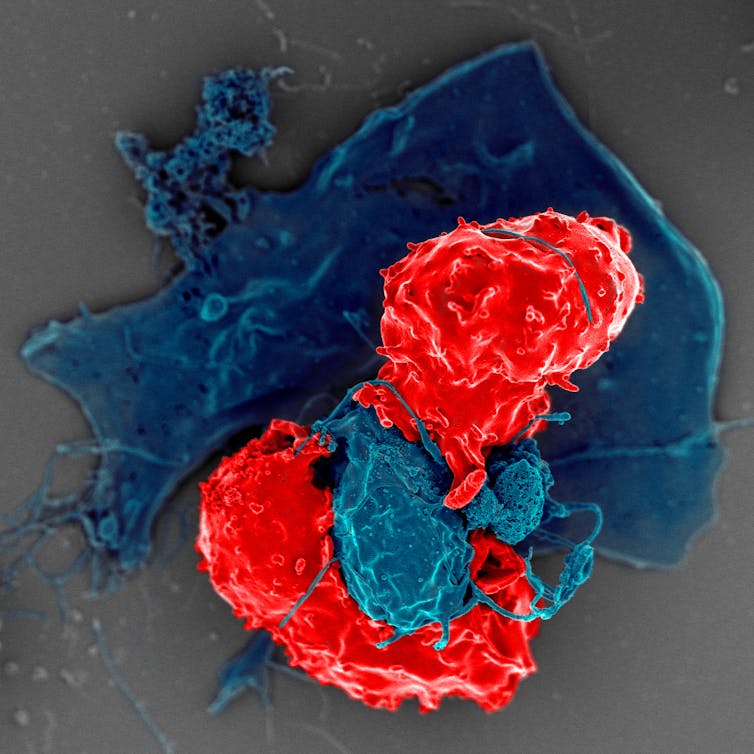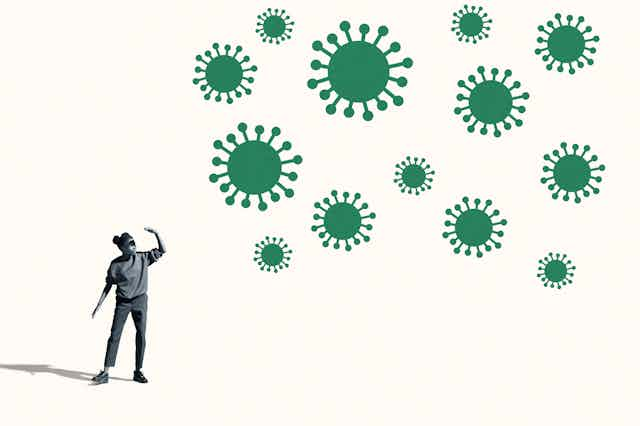
Curious Kids is a series for children of all ages. If you have a question you’d like an expert to answer, send it to curiouskidsus@theconversation.com.
What would happen if all the diseases in the world hit us at the exact same time? – Gabriella, age 12, Irving, Texas
When I was younger, I would watch “Batman” on my black-and-white television after school. Usually, Batman would face either the Joker, the Penguin, the Puzzler, Catwoman or any one of his usual opponents. However, on some occasions, Batman would have to face them all at the same time.
What would happen if, like Batman, the immune system had to face all of its rivals at once?
I am an immunologist who teaches the fundamentals of immunology to college undergraduates. My research generally focuses on factors that regulate immune responses and prevent autoimmune diseases – conditions where the immune system attacks your own body. As a scientist studying how we build immunity against pathogens such as the virus that causes COVID-19, understanding how the immune system combats multiple threats at the same time is immensely important to me.
There’s no reason why you can’t come down with strep throat at the same time as when you have a cold. In fact, sometimes fighting off one enemy can leave a hole in your defenses that another opportunistic pathogen can take advantage of.
BAM! Understanding the rivals
The first point to consider is what your immune system protects you from. The potential bad guys include cancer cells and dangerous microorganisms – including bacteria, viruses, fungi and more – that cause infections. The immune system must also be careful not to damage healthy cells and beneficial microorganisms that live on and inside you.
You interact with thousands of microorganisms with every breath of air you take. Is the immune system facing off against all of them? Sort of.

It takes a tremendous amount of energy to fight a battle once a rival gains a foothold within your blood or tissues, so your immune system works to prevent it from getting in the body in the first place. Your skin, snot, saliva and tears form a critical first line of defense. This is why burn victims who lose too much skin often die from overwhelming infection – their defensive barriers are too compromised and pathogens pour in.
The immune system greatly prefers catching a microbe in snot and blowing it out of your nose, or giving you time to wash it off the skin of your hands, over having to wage a cellular war. Gathering an army of immune cells to fight pathogens takes a lot of energy and makes you feel awful.
For example, the immune system increases your body temperature to make it an uncomfortable place for microorganisms to live and grow, but that fever can also make you want to lie down for days.
BOOM! Where are their weaknesses?
When Batman faced multiple opponents, he would find a weakness shared by all of the opponents and target it to foil their plans. The immune system uses the exact same strategy.
Certain microbes are considered pathogens largely because they are in the wrong place – such as inside your body instead of on your skin – and causing damage. Pathogens have specific parts on their surfaces called pathogen associated molecular patterns, or PAMPs.
Very importantly, your body doesn’t make PAMPS. This means if your immune system comes across a PAMP, it knows it isn’t supposed to be there and will mount an attack. Because the same PAMP is present on many different pathogens, a strategy to combat one PAMP can defeat many pathogens.
There are molecules in cells all over your body that can recognize PAMPS and destroy anything those PAMPS are on. It’s as though your immune system set up booby traps that can only attack your enemies.
Many of those booby traps are toll-like receptors. This family of molecules is located on the surface and inside of many of your cells. Once microbes contact these booby traps, they trigger an alarm that warn other cells of potential danger. In technical terms, this alarm is called inflammation.
SPLAT! Raising an army of defenders
Whereas Batman would need to think of a new strategy to combat the Joker, the Penguin and Catwoman, your immune system devised a plan long ago.
When the virus that causes COVID-19 emerged in 2019, it was something people’s immune systems likely had never seen before. However, some people already had immune cells that could target components of the virus. How is that possible?
The immune system makes many immune cells that are specific to antigens, or unique and recognizable parts of cancers and microorganisms, it hasn’t encountered before. This occurs through a process where pieces of your DNA randomly recombine to form unique immune cell receptors. The DNA in each of these immune cells is different from the DNA in any other cell in your body. Researchers believe that each person can generate at least a trillion different combinations of immune receptors, which is more than the number of pathogens an average person would ever face in their lifetime overall.
Although the immune system makes a lot of immune cells, most of them aren’t used because you’re not exposed to the antigen they’re made to recognize. However, when an immune cell recognizes an antigen, it rapidly makes many copies of itself. Since pathogens can also multiply rapidly, clonal selection allows you to rapidly raise an army to fight them.
Usually this strategy works well with one or two coinfections, such as if you have the common cold and an eye infection at the same time. But what if you were infected with a trillion pathogens at the same time? It would take a tremendous amount of energy and time to build an appropriate army against each microorganism all at once. Unfortunately, the immune system likely would be overwhelmed by this challenge, and you would probably die.
Fortunately, your immune system – like Batman – usually figures out the best way to shift a battle against rivals to its favor, pulling out a victory in the final minutes of the episode.
Hello, curious kids! Do you have a question you’d like an expert to answer? Ask an adult to send your question to CuriousKidsUS@theconversation.com. Please tell us your name, age and the city where you live.
And since curiosity has no age limit – adults, let us know what you’re wondering, too. We won’t be able to answer every question, but we will do our best.

